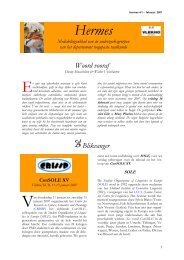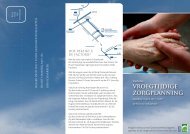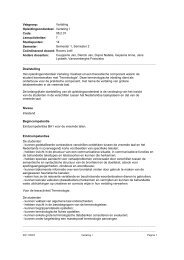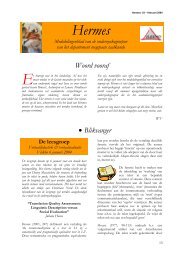HUB RESEARCH PAPER - Hogeschool-Universiteit Brussel
HUB RESEARCH PAPER - Hogeschool-Universiteit Brussel
HUB RESEARCH PAPER - Hogeschool-Universiteit Brussel
Create successful ePaper yourself
Turn your PDF publications into a flip-book with our unique Google optimized e-Paper software.
Process consultation revisited 7<br />
simultaneous enactment of engaging, experiencing and reflecting can be conceptualized in the<br />
‘relational practice’ perspective.<br />
The work with these ‘relational practices’ – i.e., how people are doing ‘things’ together<br />
and how, by interacting, they bring about change – can be documented in intensive group<br />
training and professional development processes, interpersonal work and in all kinds of OD work<br />
and change efforts. The relational practice perspective is elaborated in the second part of the<br />
article. In the third part this perspective is illustrated and extended on the basis of vignettes (short<br />
descriptions) concerning social interaction and intervention cases, illustrating how relational<br />
practices work or are hindered to work. In the concluding section we reflect on the added value<br />
of taking a relational practice perspective.<br />
Taking a ‘relational practice’ perspective<br />
Seen from a ‘relational practice’ perspective, organizational and social change processes<br />
are practical accomplishments that take place among a diversity of actors. With the concept of<br />
‘relational practice’ we want to focus on the ‘how’ of change, rather then on the ‘what’ of<br />
change. We want to focus on the way a diversity of actors involved can work together to bring<br />
about change processes. A ‘relational practice’ is any communicative or task-oriented<br />
interaction, characterized by a certain quality of interacting, among at least two actors involved;<br />
it has a consequence for the relationship and some perceivable outcome (Bouwen & Taillieu,<br />
2004). With this concept we want to shift the attention from the content of the interaction to the<br />
process of interacting, i.e., how people are doing ‘things’ together and with each other, who is<br />
included/excluded and how this is done. The quality of interacting gives an indication of ‘what<br />
really works’ in ongoing interactions for change.







